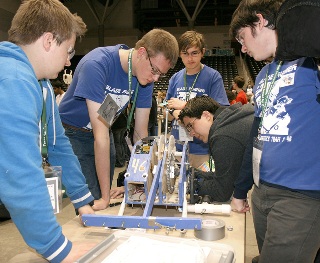Dec 4 2014
Amid cheers, tears and lots of gears, hundreds of middle and high school students competed recently in the 2014 Texas BEST Regional Robotics Championship, sponsored and hosted by UT Dallas.
 Team members from the John Jay Science and Engineering Academy address connectivity issues with their robot in the pit area between competition rounds at the 2014 Texas BEST Regional Robotics Championship.
Team members from the John Jay Science and Engineering Academy address connectivity issues with their robot in the pit area between competition rounds at the 2014 Texas BEST Regional Robotics Championship.
Sixty teams of students from Texas, New Mexico and Arizona qualified through local competitions to take part in the tournament, which was held at the Curtis Culwell Center in Garland.
For a team called the Rio Rancho Robo Runners, or R4Robotics, the long journey to North Texas from the Albuquerque area ended on a sweet note. After a daylong series of qualifying rounds, semifinals and finals against tough competition, the primarily home-schooled students took home the first-place BEST Award trophy, the highest achievement of the contest.
“I’m so excited! After all this hard work, it paid off,” said a tearful Tyler Mayer as he and his teammates hugged one another and hoisted their trophy in front of a cheering crowd. The team members donned silver capes, eye masks and frilly tutus to show team spirit.
“It’s been an up and down day,” said Suzanne Lutz, a home-school teacher and parent of an R4Robotics team member. “For weeks they practiced and practiced and practiced, and today they performed well under pressure. We’re so proud!”
The Texas event is the largest of four regional robotics championships sponsored by BEST, which stands for Boosting Engineering, Science and Technology. The BEST organization’s mission is to engage and excite students, as well as to inspire them to pursue careers in STEM fields — science, technology, engineering and mathematics.
Each year, more than 18,000 students in 20 states participate in BEST robotics. The teams receive a free basic starter kit from BEST, to which they add parts.
Students are presented with a different engineering challenge each year. For 2014, in the “Blade Runner” challenge, teams spent six weeks building remote-controlled robots that transport and assemble simulated components into a wind turbine. They also must minimize damage to roadways while preserving the habitat of the endangered prairie chicken.
On the playing field, that translated into two team members — a driver and a spotter — piloting their robot to pick up and deliver components over wooden “highways,” moving PVC-pipe prairie chickens to safety, and assembling the wind turbines made from foam and PVC pipe. In the stands, team members, family and friends noisily encouraged contestants alongside pep bands, cheerleaders and costume-clad team mascots.
Overall scores were based on several factors, including head-to-head competition, a marketing presentation, engineering notebooks, spirit and sportsmanship, team exhibit booth and an interview.
UT Dallas’ Science and Engineering Education Center (SEEC) and the Erik Jonsson School of Engineering and Computer Science have played host to the Texas BEST Regional Robotics Championship since 2011.
Dr. Kenneth Berry, regional director of Texas BEST and assistant director of SEEC, said one of the biggest changes he has seen over the years is increased participation by girls.
“That’s very gratifying, and has been positive in a number of ways,” he said, noting that the two-day championship event featured a panel discussion geared toward girls, featuring professional women engineers and sponsored by Texas Instruments.
“The girls are taking leadership roles on their teams. They think through the design, through the practice plan, the big picture stuff. They end up being leaders on their teams. It’s something I’m very pleased to see,” Berry said.
Jade Roach, a junior at Canyon High School near Amarillo, is one of six drivers and vice president of her robotics team, which she helped found three years ago.
“I have learned so much, especially the first year,” she said. “None of us knew what we were doing. I’ve learned it takes many different personalities to be a successful team. We’re getting closer to that each year we compete, and I’m really proud of that.”
Roach, who is interested in being a mechanical engineer, said the robotics experience has also taught her that engineering and technical skills are only part of what makes a successful competitor — and engineer.
“You also need to know business strategies and other things,” she said. “I was never really interested in business, but I’ve had to study and learn about it. This is a great program, and I really appreciate having all these opportunities.”
Teams in the competition earned awards in more than a dozen categories, including the most points scored in the game, creative robot design, project engineering notebook, marketing presentations and team T-shirt designs, as well as honors for the most elegant, the most robust and the most photogenic robots.
In addition to SEEC, the Jonsson School and Texas Instruments, sponsors of the event were Lockheed Martin and Rockwell Collins. The national corporate sponsor was MathWorks.